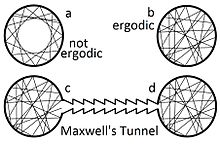
In mathematics, a dynamical system is a system in which a function describes the time dependence of a point in an ambient space, such as in a parametric curve. Examples include the mathematical models that describe the swinging of a clock pendulum, the flow of water in a pipe, the random motion of particles in the air, and the number of fish each springtime in a lake. The most general definition unifies several concepts in mathematics such as ordinary differential equations and ergodic theory by allowing different choices of the space and how time is measured. Time can be measured by integers, by real or complex numbers or can be a more general algebraic object, losing the memory of its physical origin, and the space may be a manifold or simply a set, without the need of a smooth space-time structure defined on it.
In physics, statistical mechanics is a mathematical framework that applies statistical methods and probability theory to large assemblies of microscopic entities. Sometimes called statistical physics or statistical thermodynamics, its applications include many problems in the fields of physics, biology, chemistry, neuroscience, computer science, information theory and sociology. Its main purpose is to clarify the properties of matter in aggregate, in terms of physical laws governing atomic motion.
In physics, specifically statistical mechanics, an ensemble is an idealization consisting of a large number of virtual copies of a system, considered all at once, each of which represents a possible state that the real system might be in. In other words, a statistical ensemble is a set of systems of particles used in statistical mechanics to describe a single system. The concept of an ensemble was introduced by J. Willard Gibbs in 1902.
Liouville's theorem has various meanings, all mathematical results named after Joseph Liouville:

The phase space of a physical system is the set of all possible physical states of the system when described by a given parameterization. Each possible state corresponds uniquely to a point in the phase space. For mechanical systems, the phase space usually consists of all possible values of the position and momentum parameters. It is the direct product of direct space and reciprocal space. The concept of phase space was developed in the late 19th century by Ludwig Boltzmann, Henri Poincaré, and Josiah Willard Gibbs.
Ergodic theory is a branch of mathematics that studies statistical properties of deterministic dynamical systems; it is the study of ergodicity. In this context, "statistical properties" refers to properties which are expressed through the behavior of time averages of various functions along trajectories of dynamical systems. The notion of deterministic dynamical systems assumes that the equations determining the dynamics do not contain any random perturbations, noise, etc. Thus, the statistics with which we are concerned are properties of the dynamics.
In physics, Liouville's theorem, named after the French mathematician Joseph Liouville, is a key theorem in classical statistical and Hamiltonian mechanics. It asserts that the phase-space distribution function is constant along the trajectories of the system—that is that the density of system points in the vicinity of a given system point traveling through phase-space is constant with time. This time-independent density is in statistical mechanics known as the classical a priori probability.
In physics, critical phenomena is the collective name associated with the physics of critical points. Most of them stem from the divergence of the correlation length, but also the dynamics slows down. Critical phenomena include scaling relations among different quantities, power-law divergences of some quantities described by critical exponents, universality, fractal behaviour, and ergodicity breaking. Critical phenomena take place in second order phase transitions, although not exclusively.
In statistical mechanics, a canonical ensemble is the statistical ensemble that represents the possible states of a mechanical system in thermal equilibrium with a heat bath at a fixed temperature. The system can exchange energy with the heat bath, so that the states of the system will differ in total energy.
A Hamiltonian system is a dynamical system governed by Hamilton's equations. In physics, this dynamical system describes the evolution of a physical system such as a planetary system or an electron in an electromagnetic field. These systems can be studied in both Hamiltonian mechanics and dynamical systems theory.

In physics, symmetry breaking is a phenomenon where a disordered but symmetric state collapses into an ordered, but less symmetric state. This collapse is often one of many possible bifurcations that a particle can take as it approaches a lower energy state. Due to the many possibilities, an observer may assume the result of the collapse to be arbitrary. This phenomenon is fundamental to quantum field theory (QFT), and further, contemporary understandings of physics. Specifically, it plays a central role in the Glashow–Weinberg–Salam model which forms part of the Standard model modelling the electroweak sector.
In mathematics and physics, the Poincaré recurrence theorem states that certain dynamical systems will, after a sufficiently long but finite time, return to a state arbitrarily close to, or exactly the same as, their initial state.
In physics, maximum entropy thermodynamics views equilibrium thermodynamics and statistical mechanics as inference processes. More specifically, MaxEnt applies inference techniques rooted in Shannon information theory, Bayesian probability, and the principle of maximum entropy. These techniques are relevant to any situation requiring prediction from incomplete or insufficient data. MaxEnt thermodynamics began with two papers by Edwin T. Jaynes published in the 1957 Physical Review.

In statistical mechanics, a microstate is a specific configuration of a system that describes the precise positions and momenta of all the individual particles or components that make up the system. Each microstate has a certain probability of occurring during the course of the system's thermal fluctuations.
In mathematics, ergodicity expresses the idea that a point of a moving system, either a dynamical system or a stochastic process, will eventually visit all parts of the space that the system moves in, in a uniform and random sense. This implies that the average behavior of the system can be deduced from the trajectory of a "typical" point. Equivalently, a sufficiently large collection of random samples from a process can represent the average statistical properties of the entire process. Ergodicity is a property of the system; it is a statement that the system cannot be reduced or factored into smaller components. Ergodic theory is the study of systems possessing ergodicity.

In quantum chaos, a branch of mathematical physics, quantum ergodicity is a property of the quantization of classical mechanical systems that are chaotic in the sense of exponential sensitivity to initial conditions. Quantum ergodicity states, roughly, that in the high-energy limit, the probability distributions associated to energy eigenstates of a quantized ergodic Hamiltonian tend to a uniform distribution in the classical phase space. This is consistent with the intuition that the flows of ergodic systems are equidistributed in phase space. By contrast, classical completely integrable systems generally have periodic orbits in phase space, and this is exhibited in a variety of ways in the high-energy limit of the eigenstates: typically, some form of concentration occurs in the semiclassical limit .
The Koopman–von Neumann (KvN) theory is a description of classical mechanics as an operatorial theory similar to quantum mechanics, based on a Hilbert space of complex, square-integrable wavefunctions. As its name suggests, the KvN theory is loosely related to work by Bernard Koopman and John von Neumann in 1931 and 1932, respectively. As explained in this entry, however, the historical origins of the theory and its name are complicated.
The eigenstate thermalization hypothesis is a set of ideas which purports to explain when and why an isolated quantum mechanical system can be accurately described using equilibrium statistical mechanics. In particular, it is devoted to understanding how systems which are initially prepared in far-from-equilibrium states can evolve in time to a state which appears to be in thermal equilibrium. The phrase "eigenstate thermalization" was first coined by Mark Srednicki in 1994, after similar ideas had been introduced by Josh Deutsch in 1991. The principal philosophy underlying the eigenstate thermalization hypothesis is that instead of explaining the ergodicity of a thermodynamic system through the mechanism of dynamical chaos, as is done in classical mechanics, one should instead examine the properties of matrix elements of observable quantities in individual energy eigenstates of the system.
Ergodicity economics is a research programme that applies the concept of ergodicity to problems in economics and decision-making under uncertainty. The programme's main goal is to understand how traditional economic theory, framed in terms of the expectation values, changes when replacing expectation value with time averages. In particular, the programme is interested in understanding how behaviour is shaped by non-ergodic economic processes, that is processes where the expectation value of an observable does not equal its time average.






